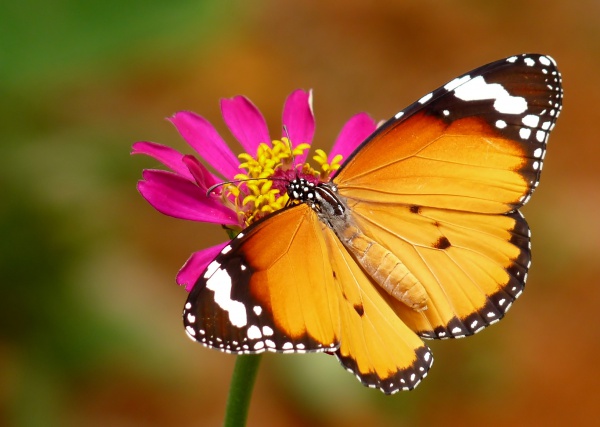Facts About Danaus chrysippus
The plain tiger butterfly, scientifically known as *Danaus chrysippus*, is a medium-sized butterfly found in Asia, Australia, and Africa. It belongs to the Danainae subfamily within the Nymphalidae family. This butterfly feeds on milkweed plants, which contain toxic compounds known as cardenolides. These toxins render the plain tiger unpalatable to predators. Its distinct coloration also serves as a deterrent, with other species mimicking it to evade predation.
These butterflies are commonly found in a variety of habitats but particularly thrive in dry, open areas. There are three main subspecies: *D. c. alcippus*, *D. c. chrysippus*, and *D. c. orientis*, each occupying different regions within its range.
With a wingspan of about 7–8 cm, the plain tiger butterfly is quite striking. It has a black body with white spots and orange wings marked with black and white patterns. Like other butterflies, it undergoes several life stages: egg, caterpillar, pupa, and adult. Females lay their eggs on the underside of leaves of plants that their larvae will eat. The larvae progress through five stages (called instars) before becoming pupae and eventually emerging as butterflies.
Predators such as birds and parasitic organisms like flies and wasps pose threats to this butterfly. Intriguingly, a type of male-killing bacteria called *Spiroplasma* infects female plain tigers, resulting in all-female broods. To deter predators, the plain tiger utilizes its toxic diet, exhibiting protective coloration. This has led other species to mimic the plain tiger's appearance for protection, a phenomenon known as Batesian and Müllerian mimicry.
Genetically, the plain tiger comprises several subspecies, with some populations showing signs of ongoing evolutionary changes. During courtship and mating, males use pyrrolizidine alkaloids to release pheromones stored in hair-pencils, which helps attract females. Females typically mate multiple times, ensuring the continuation of the species.

 Israel
Israel